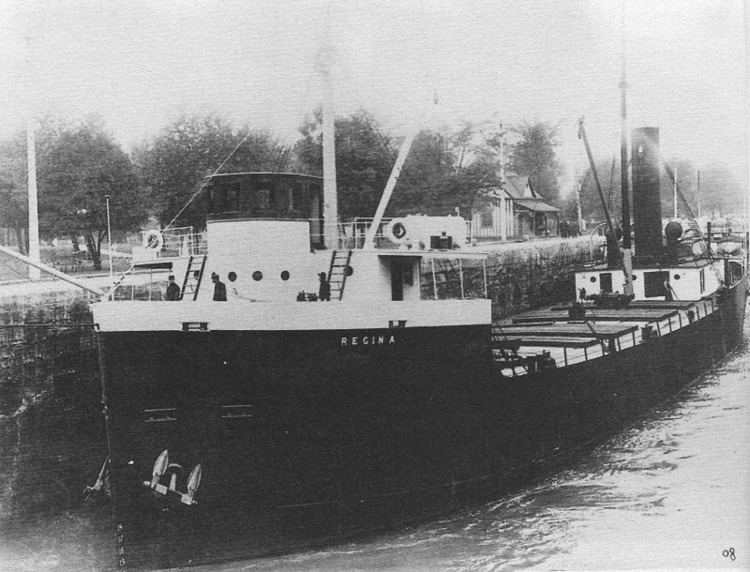Name Regina Yard number 419 Maiden voyage January 19, 1907 | Completed October 1907 Launched 4 September 1907 | |
 | ||
Owner Canada Steamship Lines Inc. | ||
The SS Regina was a steel canaler built for the Merchant Mutual Line and home ported in Montreal, Quebec. Named after Regina, Saskatchewan, Regina had a tonnage of 1,956 gross register tons (GRT) and a crew of 32.
Contents
The ship sank during the Great Lakes Storm of 1913 after taking great damage. Lost for more than a half century, she became known as the "Great Mystery of the Great Storm of the Great Lakes". Since found, she has become an active dive site for scuba divers and is now part of Michigan's underwater Preserve system.
History
In 1907, Regina was built in Dumbarton, Scotland by A. McMillian & Son. The order was placed by C.H.F. Plummer of Montreal, Quebec. In 1911 ownership was transferred to the Canadian Lake Transportation Company and in 1912 it was transferred to the Canadian Steamship Lines Incorporated.
The early years of Regina contain little recorded information. There was little interest for the ship until 1913, when she was caught in the Great Lakes Storm of 1913.
Sinking
On November 9, 1913 Regina was heading north from. During the night one of the worst storms in Great Lakes history arose. Waves ranged up to 38 feet. At the time, Regina was top-heavy with a load of sewer pipes.
The ship anchored approximately 7 miles (11 km) east of Lexington, Michigan. All power was shut down.
After anchoring, Regina capsized and sank, taking the captain to the bottom of Lake Huron. Near Port Franks, Ontario, two bodies were found with a capsized lifeboat from Regina and another 10 bodies were found on the beach a short distance away. There were no survivors from Regina.
Sailors initially theorized that Regina collided with Charles S. Price, another ship sunk in the storm, as some of the bodies of Charles S. Price's crewmen were wearing lifebelts from Regina. However, this theory was dismissed after Charles S. Price was found on the bottom of Lake Huron; a diver confirmed that the ship was Charles S. Price and that the ship showed no signs of being in a collision.
Aftermath
Twelve ships foundered in the Great Lakes Storm of 1913 and there was confusion in determining where the shipwrecks were located. The day following the storm, November 10, 1913 a huge steel freighter was floating bottom side up, the bow about thirty feet clear of the water but the stern dipping down until it was impossible to tell the length of the carrier. Every visible part of the hulk was coated with ice and there were no identifying marks in view. Originally, people assumed this vessel was Regina which had been lost the previous day. It was not until early Saturday morning, November 15, that the ship was identified as Charles S. Price, shortly before she sank on November 17. The front page of that day's Port Huron Times-Herald extra edition read, "BOAT IS PRICE — DIVER IS BAKER — SECRET KNOWN."
Discovery & Salvage
The wreck of Regina was discovered in 1986 in Lake Huron between Lexington and Port Sanilac, Michigan. The wreck is largely intact but is upside down and in about 77–80 feet of water. She was discovered by Wayne Brusate, Garry Biniecki and John Severance. During a 1987 archaeological salvage expedition led by underwater archaeologist and shipwreck expert E. Lee Spence, tens of thousands of artifacts, including hundreds of intact bottles of still potable Scotch and Champagne were recovered.
